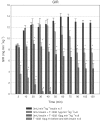T-1032, a cyclic GMP phosphodiesterase-5 inhibitor, acutely blocks physiologic insulin-mediated muscle haemodynamic effects and glucose uptake in vivo
- PMID: 14581178
- PMCID: PMC1574135
- DOI: 10.1038/sj.bjp.0705548
T-1032, a cyclic GMP phosphodiesterase-5 inhibitor, acutely blocks physiologic insulin-mediated muscle haemodynamic effects and glucose uptake in vivo
Abstract
1. Cyclic GMP phosphodiesterase-5 inhibitors have been shown to alter blood flow in specific tissues by potentiating local NO-dependent vasodilatory mechanisms. Since the haemodynamic effects of physiologic insulin, particularly capillary recruitment, may be critical for muscle glucose uptake in vivo and are blocked by inhibitors of nitric oxide synthase, we have explored the acute effects of the specific cGMP phosphodiesterase-5 inhibitor T-1032 on physiologic insulin action in anaesthetized healthy rats in vivo. 2. Whole-body glucose infusion (GIR), femoral blood flow (FBF), hind leg vascular resistance (VR), hind leg glucose uptake (HGU), 2-deoxyglucose uptake into muscles of the lower leg (R'g), hind leg metabolism of infused 1-methylxanthine (1-MX), a measure of capillary recruitment, and muscle cGMP were determined. The experimental groups were T-1032 (10 microg min-1 kg-1) infused for 1 h before and during a euglycaemic insulin clamp (3 mU min-1 kg-1 x 2 h), T-1032 infused for 3 h with saline, T-1032 during a 2 h clamp, T-1032 with saline for 2 h, and a 2 h saline control. 3. Insulin increased GIR from zero to 13 mg min-1 kg-1, HGU from 0.1+/-0.01 to 0.43+/-0.05 micromol min-1, R'g and 1-MX, marginally increased FBF, and had no effect on blood pressure or heart rate. T-1032 alone had no effect on blood pressure, heart rate, FBF, VR, HGU, R'g or 1-MX, but increased muscle cGMP. T-1032 1 h before and during insulin completely blocked GIR (1 h), HGU (2 h), R'g (2 h), and 1-MX (2 h). T-1032 commenced with insulin had only partial blocking activity against insulin. 4. We conclude that T-1032 is a potent acutely acting inhibitor of the muscle effects of physiologic insulin on capillary recruitment and glucose uptake in vivo. These, together with inhibition of whole-body glucose infusion during insulin, may caution against the use of isoenzyme-5-specific cyclic GMP phosphodiesterase inhibitors as therapeutic agents.
Figures





References
-
- BALON T.W. Integrative biology of nitric oxide and exercise. Exerc. Sport Sci. Rev. 1999;27:219–253. - PubMed
-
- BALON T.W., NADLER J.L. Nitric oxide mediates skeletal glucose transport. Am. J. Physiol. 1996;270:E1058–E1059. - PubMed
-
- BALON T.W., NADLER J.L. Evidence that nitric oxide increases glucose transport in skeletal muscle. J. Appl. Physiol. 1997;82:359–363. - PubMed
-
- BARON A.D., LAAKSO M., BRECHTEL G., HOIT B., WATT C., EDELMAN S.V. Reduced postprandial skeletal muscle blood flow contributes to glucose intolerance in human obesity. J. Clin. Endocrinol. Metab. 1990;70:1525–1533. - PubMed
-
- BRENMAN J.E., CHAO D.S., XIA H., ALDAPE K., BREDT D.S. Nitric oxide synthase complexed with dystrophin and absent from skeletal muscle sarcolemma in Duchenne muscular dystrophy. Cell. 1995;82:743–752. - PubMed
Publication types
MeSH terms
Substances
LinkOut - more resources
Full Text Sources
Other Literature Sources
Medical
Research Materials
Miscellaneous

